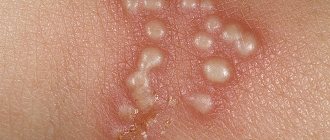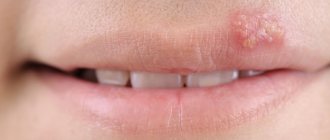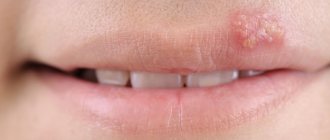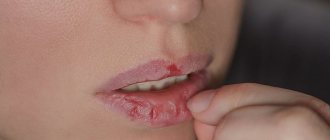Many people are familiar with the expression “ cold lips . It is usually used when a bubble with transparent contents forms in the lip area, which subsequently bursts and the affected area becomes covered with a crust. Cold sores are an infectious disease caused by the herpes simplex virus type 1 or 2. The source of infection can be infected people, both with and without pronounced signs of herpes. Cold sores on the lips are not limited to the presence of the virus only in this area. In patients the herpes virus is detected in such body fluids as blood (including menstrual fluid), urine, discharge from the nose and tear ducts, vaginal secretions, amniotic fluid and sperm. How the virus is transmitted and how to treat herpes is discussed in this article.
How does herpes infection occur?
As mentioned above, colds on the lips are caused by two types of viruses - herpes virus type 1 and herpes virus type 2 . Infection with herpes virus type 1 mainly occurs in childhood and adolescence. The main routes of transmission of infection are contact (for example, through personal objects) and airborne droplets (by inhaling the virus, kissing). However, infection can also occur through oral-genital contact. Infection with herpes virus type 2 occurs through direct sexual contact and is therefore more common among young people and adults. Transmission of pathogens of both types 1 and 2 can occur from mother to fetus (transplacentally), and also in isolated cases through infected blood products (parenterally). It is worth noting that the risk of infection increases significantly if an infected person has herpetic rashes on the skin and mucous membranes.
Prevention
For those infected with herpesvirus type 1, it is generally almost impossible to completely avoid the appearance of cold sores on the lips. You can only reduce the risks of its occurrence due to reactivation of the virus. To do this, first of all, you should use the usual methods of maintaining immunity (a healthy lifestyle, a nutritious and varied diet, a minimum of stress, etc.). However, herpes on the lips can also occur unexpectedly, for no apparent reason.
Particular attention should be paid to prevention for infants and young children, since primary infection can have serious consequences due to imperfect immune defense. It is believed that it is most important to avoid too early infection with herpes viruses (which is almost inevitable later), for example, transmission of the virus from a nursing mother. If signs of a herpetic lesion appear in the mother or surrounding people, precautions should be taken: no close contact with a small child, stricter personal hygiene.
Request a consultation
Forms of herpetic infection
There are several forms of herpes infection. The bullous form of herpes is characterized by the appearance of blisters that can reach the size of a plum. The abortive form occurs without the formation of a blistering rash, and at the site of the lesion there is swelling and small cone-shaped elevations above the surface of the skin or mucous membranes. The most severe forms of herpes are ulcerative, ulcerative-necrotic and gangrenous. They are characterized by the appearance of vesicles with hemorrhagic contents, the appearance of long-term non-healing deep ulcers that leave scars. The development of the gangrenous form occurs in people weakened by any diseases, as well as in elderly patients with gastric ulcers, diabetes mellitus and other concomitant pathologies.
Factors causing the disease
The herpes virus may be present in our body, but not manifest itself. The disease begins to develop under certain factors - the virus is activated. The reasons for the appearance of herpes on the face are the same as the reasons for the appearance of herpetic blisters on other areas of the skin:
- hypothermia;
- violation of work and rest schedules;
- hypovitaminosis (regardless of the time of year);
- fatigue;
- chronic disorders of the immune system.
For relapses, it is also important that a periodically ill person does not attach importance to herpes and lets everything take its course, each time expecting that “it will go away on its own.”
Provocateurs of herpes infection
Colds on the lips rarely have an acute form; a chronic course of the disease is much more common. According to WHO, approximately 70% of people around the world are infected with the herpes simplex virus and about 10-20% of patients experience various symptoms of herpes infection. Exacerbations of chronic herpes occur for a number of reasons. The main factors that lead to relapse are emotional and physical stress, hypothermia, sexual intercourse, menstruation in women, concomitant diseases (ARVI, including influenza), ultraviolet radiation and others.
Symptoms of herpes on the lips
Quite often, the first symptoms of herpes on the lips are almost unnoticeable - mild irritation of the affected areas, their increased sensitivity. Subsequently, visible symptoms appear: inflamed and painful blisters, possible purulent plaque on the mucous membranes of the lips, and in some cases, inflammation of the lymph nodes.
Primary infection with the virus usually occurs with mild or moderate damage. Reactivation of the virus leads to more pronounced symptoms of herpes on the lips, but in some cases there are practically no external symptoms. The intervals between repeated outbreaks can be very varied, and are mainly associated with the frequency of provoking factors. Mild forms of this disease pass quite quickly, but when they become severe, they require specific treatment, since complications are possible.
Why is the herpes virus dangerous?
The herpes simplex virus affects many organs and systems. Herpetic blisters can appear on the mucous membranes of the vagina, cervix, urethra, mouth and skin, and with an extensive process they can appear in the liver and brain. Herpes can cause dysfunction of both the autonomic and central nervous systems. In addition, the herpes virus is associated with cancer, unfavorable pregnancy, childbirth, as well as pathologies in the fetus and newborns. According to the World Health Organization, the mortality rate from severe forms of the herpes simplex virus is 15.8% compared to other viral infections and ranks second after deaths from influenza (35.8%). In our country, the number of patients diagnosed with herpes infection every year exceeds 2.5 million. Patients with chronic herpetic lesions of the skin and genitals make up more than 10% of the total population of Russia.
Complications of herpes on the lips
With mild or moderate inflammation, it disappears on its own. However, in infants and young children, for whom this is a primary infection, the symptoms of herpes on the lips and its consequences can become dangerous. But essentially this is due to the general primary infection of the child’s body with herpesvirus type 1.
Generalized infection. External symptoms are mild, but the general condition of a small child’s body resembles sepsis. Foci of infection are localized in the internal organs (lungs, liver, kidneys, spleen, brain), and can even lead to respiratory failure.
Transition to other organs and systems of the body. It is possible to transfer herpetic lesions to the skin, oral cavity, and eyes. In the visual system, inflammation of the cornea and conjunctiva (keratoconjunctivitis), as well as the retina and choroid (chorioretinitis) is possible.
Inflammation of the brain (encephalitis). The child has a high fever, severe lethargy, tense fontanel, convulsive seizures and coma are possible.
Reactivation of the virus (secondary infection) with symptoms of herpes on the lips can also lead to complications. Most often, the lesion spreads to the eyes - inflammation of the cornea (herpetic keratoconjunctivitis) with its clouding, scarring, visual impairment, even to the point of blindness.
An extremely dangerous complication is inflammation of the brain (encephalitis). In adults and older children, it can take an acute form, in which only three out of ten people survive without treatment.
Treatment of herpes
The herpes virus enters the body through the mucous membranes and settles in the nerve ganglia for life. Therefore, it is impossible to completely get rid of the pathogen. However, with proper therapy, it is possible to reduce the intensity of the rash, significantly reduce the duration of the prodromal period and reduce the frequency of exacerbations. Treatment of herpes at home includes antiviral therapy using antiherpetic drugs. But since colds on the lips are accompanied by immunodeficiency, the treatment regimen also includes immunomodulatory agents, for example, interferon preparations or its inducers. In the combined treatment of herpes, the drug Viferon can be used, which resists viruses and corrects protective functions. Using the drug in a treatment regimen allows you to quickly relieve the symptoms of herpes and prolong remission. In addition, the good tolerability of the drug makes it possible to use it in children and pregnant women.
Based on materials:
1. Malinovskaya V.V., Delenyan N.V. et al. "Viferon". Guide for doctors. M. 2004. 6. Malinovskaya V.V., Uchaikin “Viferon (suppositories and gel) in the complex therapy of herpes virus infections”, A.A. Haldin, D.V. Baskakova, A.N. Vasiliev. 2. “Algorithm for the treatment of exacerbations and secondary prevention of herpes simplex with Viferon”, A. A. Khaldin, I. V. Polesko. 3. “Algorithm for the treatment of exacerbations and secondary prevention of herpes simplex with Viferon”, Haldin A.A., Polesko I.V.
Loading...
Take other surveys
Causes of herpes on the face, treatment, prevention
They say about herpes: “small but vicious.”
After all, the size of the lesion is small, but subjectively it is very disturbing. Many of us have asked the question: “Which doctor should we contact to treat herpes on the lips in order to get rid of the disease once and for all?” – because this disease can recur more than once, appearing at the most inopportune moment. Herpes is a viral disease that manifests itself in small infiltrates that develop into vesicles (cavities with liquid). The symptoms of herpes simplex infection are too typical not to recognize the painful blisters that torment a person for several days. Theoretically, pathology can develop on any part of the skin of the human body. But most often the virus “loves” to infect:
- the mucous membrane of the lips is the area most often “visited” by the pathogen;
- the border of the mucous membrane of the lips and skin around the mouth;
- conjunctiva;
- cornea;
- external genitalia (both men and women).
Unfortunately, injections or pills have not yet been invented to prevent herpes. Therefore, you should study the information about it well in order to successfully fight the disease at the first signs of manifestation, and, if possible, prevent it. You should especially be wary of herpes on the lips of women in early pregnancy. Its presence means that a viral agent has entered the body of the expectant mother, which can affect the intrauterine development of the fetus.
How to figure out what kind of runny nose you have
The first distinguishing feature is the color of the snot. If a green or green-yellow tint appears, it means that the nature of the runny nose is most likely bacterial. However, to determine whether a runny nose is viral or bacterial, you need to pay attention not only to the color of nasal discharge, but also to other symptoms.
If a person’s health worsens, the temperature rises to high levels, the disease continues to progress and does not go away after 10 days or more, it is necessary to consult a doctor. The specialist will prescribe a general blood test, rhinoscopy, and laboratory testing of a smear from the nasal canals.
Diagnosis of the disease
Herpetic blisters look so characteristic that they cannot be confused with the morphological signs of other diseases - neither with an abscess, nor with specific ulcerations, nor with an allergic rash. In the vast majority of cases, the diagnosis is made on the basis of clinical manifestations.
A blood test for antibodies to the herpes simplex virus is an indirect method of identifying the pathogen in the body. It can be used if the body’s reactivity (the intensity of the response to external harmful agents) is low, and the infiltrate does not develop into characteristic blisters, which raises the question among clinicians: is it herpes?
Herpes simplex, which is manifested purely by a rash on the face, should be distinguished from herpes type 6, which is characterized not only by a rash, but also by a sharp increase in temperature.
Symptoms of herpes simplex infection
There are few signs of herpes, but they are all very characteristic. Therefore, difficulties in differential diagnosis almost never arise.
The main symptoms of infection with herpes simplex, which is the most common form of herpetic lesions, are as follows:
- painful tissue swelling appears in the affected area;
- after 1-2 days it transforms into a denser infiltrate;
- the infiltrate turns into a bubble with liquid;
- the blister bursts and a painful ulcer forms in its place;
- the ulceration dries out and is covered with a new layer of epithelium - the wound heals.
The way lips look after herpes is the same as after any other skin disease: the swelling disappears, but the ulcer cannot heal for some time. It is covered with a yellowish film that constantly “peels off” from the wound surface, thereby exposing the wound and delaying the process of epithelial regeneration at the site of the lesion.
- Stress or emotional distress;
- Various somatic diseases, in particular colds, flu, diabetes, HIV;
- Poisoning or intoxication;
- Drinking alcohol, caffeine and smoking;
- Excessive ultraviolet radiation;
- Hypothermia or overheating;
- The arrival of menstruation;
- Overwork and exhaustion;
- Inadequate nutrition (diet) or stomach upset;
- Other factors individual to each person.
After activation, the virus travels along nerves from the trigeminal ganglion back to the skin.
It is important to know that the trigeminal plexus gives off branches that innervate the lips, oral mucosa, gums, skin on the earlobe and part of the cheek. Lesions on the skin will be located in accordance with the exiting nerves. As the virus travels through a nerve, it causes inflammation of the nerve tissue, which causes pain along the nerve fiber. In its development, herpes on the lips goes through stage IV:
Stage I of herpes - tingling. This is when most people feel like they are getting sick. Before a cold sore appears on the lips, the skin in the corners of the mouth or the inner surface of the lips, or on the tongue, or even all over the face begins to itch. In the place where a relapse of herpes will soon develop, harbingers of the disease appear: pain, tingling, tingling, itching. The skin over the site of future relapse turns red. The development of herpes can be prevented if acyclovir-based drugs are used at this stage. If you are experiencing severe itching, you can take an aspirin or paracetamol tablet.
Stage II of herpes - the stage of inflammation, begins with a small painful vesicle, which gradually increases in size. The bubble is tense and filled with a clear liquid, which later becomes cloudy.
Stage III of herpes is the ulceration stage. The bubble bursts and a colorless liquid oozes out, filled with billions of viral particles. An ulcer forms in its place. At this moment, the sick person is very contagious, as he releases a huge amount of viral particles into the environment. Due to the pain and sores on the face, this stage is the most annoying for a person.
Stage IV of herpes - scab formation. A crust forms over the ulcers, and if damaged, it can cause pain and bleeding.
Herpes rashes are most often located on the red border of the lips, but can also be on the nose, on the cheeks, in the ears, on the forehead, in the oral cavity: on the gums, the inner surface of the lips and cheeks.
Strictly observe the rules of personal hygiene. “Colds” on the lips are contagious! Always wash your hands with soap and water before and after touching cold sores, including after applying antiviral cream.
Don't touch your eyes! (especially women while applying makeup). Do not use saliva to wet contact lenses. Despite the itching and pain, you should not touch the rash, kiss, especially with children, use someone else's lipstick or borrow your own, or smoke one cigarette with a friend. Do not attempt to remove blisters or scabs to avoid spreading the infection to other parts of the body or causing a bacterial infection.
Avoid oral sex! Oral sex during a “cold” on the lips of an “active” partner can cause genital herpes in a partner passively participating in oral sex. In this case, herpes from the lips of the “active” partner can be transferred to the genitals of the partner receiving caresses.
If you have a cold on your lips, use individual dishes or a towel, and do not drink from someone else’s glasses.










